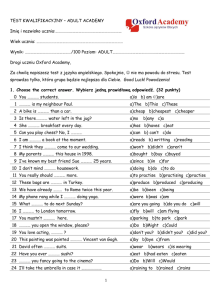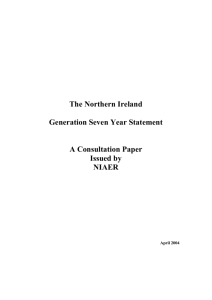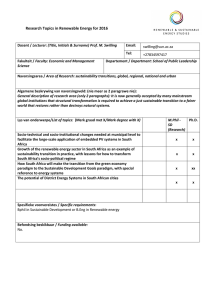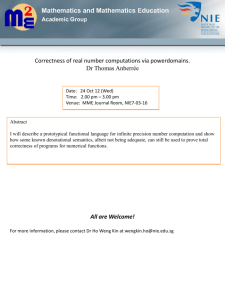Network Integration Evaluation (NIE)
advertisement
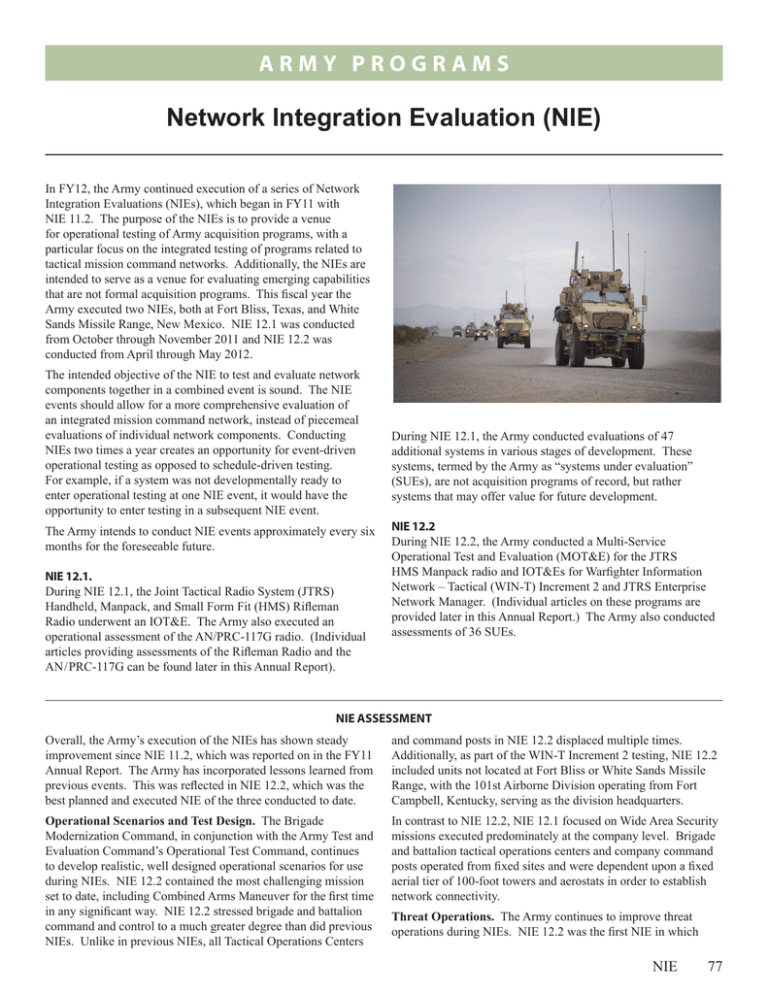
ARMY PROGRAMS Network Integration Evaluation (NIE) In FY12, the Army continued execution of a series of Network Integration Evaluations (NIEs), which began in FY11 with NIE 11.2. The purpose of the NIEs is to provide a venue for operational testing of Army acquisition programs, with a particular focus on the integrated testing of programs related to tactical mission command networks. Additionally, the NIEs are intended to serve as a venue for evaluating emerging capabilities that are not formal acquisition programs. This fiscal year the Army executed two NIEs, both at Fort Bliss, Texas, and White Sands Missile Range, New Mexico. NIE 12.1 was conducted from October through November 2011 and NIE 12.2 was conducted from April through May 2012. The intended objective of the NIE to test and evaluate network components together in a combined event is sound. The NIE events should allow for a more comprehensive evaluation of an integrated mission command network, instead of piecemeal evaluations of individual network components. Conducting NIEs two times a year creates an opportunity for event-driven operational testing as opposed to schedule-driven testing. For example, if a system was not developmentally ready to enter operational testing at one NIE event, it would have the opportunity to enter testing in a subsequent NIE event. The Army intends to conduct NIE events approximately every six months for the foreseeable future. NIE 12.1. During NIE 12.1, the Joint Tactical Radio System (JTRS) Handheld, Manpack, and Small Form Fit (HMS) Rifleman Radio underwent an IOT&E. The Army also executed an operational assessment of the AN/PRC-117G radio. (Individual articles providing assessments of the Rifleman Radio and the AN / PRC‑117G can be found later in this Annual Report). During NIE 12.1, the Army conducted evaluations of 47 additional systems in various stages of development. These systems, termed by the Army as “systems under evaluation” (SUEs), are not acquisition programs of record, but rather systems that may offer value for future development. NIE 12.2 During NIE 12.2, the Army conducted a Multi-Service Operational Test and Evaluation (MOT&E) for the JTRS HMS Manpack radio and IOT&Es for Warfighter Information Network – Tactical (WIN-T) Increment 2 and JTRS Enterprise Network Manager. (Individual articles on these programs are provided later in this Annual Report.) The Army also conducted assessments of 36 SUEs. NIE Assessment Overall, the Army’s execution of the NIEs has shown steady improvement since NIE 11.2, which was reported on in the FY11 Annual Report. The Army has incorporated lessons learned from previous events. This was reflected in NIE 12.2, which was the best planned and executed NIE of the three conducted to date. and command posts in NIE 12.2 displaced multiple times. Additionally, as part of the WIN-T Increment 2 testing, NIE 12.2 included units not located at Fort Bliss or White Sands Missile Range, with the 101st Airborne Division operating from Fort Campbell, Kentucky, serving as the division headquarters. Operational Scenarios and Test Design. The Brigade Modernization Command, in conjunction with the Army Test and Evaluation Command’s Operational Test Command, continues to develop realistic, well designed operational scenarios for use during NIEs. NIE 12.2 contained the most challenging mission set to date, including Combined Arms Maneuver for the first time in any significant way. NIE 12.2 stressed brigade and battalion command and control to a much greater degree than did previous NIEs. Unlike in previous NIEs, all Tactical Operations Centers In contrast to NIE 12.2, NIE 12.1 focused on Wide Area Security missions executed predominately at the company level. Brigade and battalion tactical operations centers and company command posts operated from fixed sites and were dependent upon a fixed aerial tier of 100-foot towers and aerostats in order to establish network connectivity. Threat Operations. The Army continues to improve threat operations during NIEs. NIE 12.2 was the first NIE in which NIE 77 Army PROGRAMS threat information operations, such as electronic warfare and computer network operations, were fully integrated into the threat commander’s scheme of maneuver. An aggressive, adaptive threat intent on winning the battle is an essential component of good operational testing. The Army should continue to ensure that future NIEs contain a robust threat force, to include threat information warfare capabilities. Schedule-Driven Programs. The Army remains schedule-driven to meet NIE objectives, vice pursuing an event-driven schedule appropriate to acquisition system development. In NIE 12.1 the Army proceeded to the Rifleman Radio IOT&E despite unfinished developmental testing. Developmental testing conducted prior to the IOT&E indicated that the Rifleman Radio was demonstrating reliability of roughly one-half its intended requirement (277 hours of Mean Time Between Essential Function Failure (MTBEFF) compared to a requirement of 477 hours). Predictably, Rifleman Radio’s reliability demonstrated during the IOT&E fell far short of the requirement, demonstrating a 161-hour MTBEFF. In NIE 12.2, the Army proceeded with the Manpack radio MOT&E despite developmental testing results indicating that the Manpack radio Single Channel Ground and Airborne Radio System (SINCGARS) waveform performance was not satisfactory and that the Manpack radio was falling short of its reliability requirements. The OSD’s Deputy Assistant Secretary of Defense for Developmental Test and Evaluation in its Assessment of Operational Test Readiness (AOTR) identified these developmental testing deficiencies prior to the start of the MOT&E. The Manpack radio MOT&E results confirmed both the SINCGARS waveform deficiency and reliability shortfall previously identified in developmental testing. Furthermore, Manpack radio vehicle integration was poorly executed and not adequately tested prior to the MOT&E, resulting in poor vehicular-mounted radio performance in the MOT&E. The AOTR also identified insufficient developmental testing to assess vehicle integration prior to the MOT&E. According to system development best practices, the Army should not proceed to IOT&E with a system until it has completed developmental testing and the program has 78 NIE corrected any identified problems. Otherwise, the Army runs the risk of conducting costly operational tests that only serve to confirm developmental testing conclusions about poor system performance, without affording the Program Office the opportunity to fix system shortfalls. Too Many Systems. The Army continues to insert a large number of immature systems into NIEs. The 25 SUEs contained in the NIE 11.2 stressed the Army’s evaluation capacity, indicating a need to reduce the number of SUEs in later NIEs. Nevertheless, NIE 12.1 contained 47 SUEs and NIE 12.2 included 36 SUEs. Too many immature systems in the NIE challenges the Army’s capacity to employ appropriate instrumentation, collect relevant data, and conduct full and adequate assessments, detracting from the Army’s capability to perform focused evaluations. Having this large number of SUEs in the NIE stresses the test unit’s capacity to adequately train operators on the new systems. In addition, it strains the unit’s ability to understand the systems’ intended concepts of operations and to integrate the systems into unit operations. These limitations make it challenging to thoroughly examine the capabilities of each SUE. Finally, much of the NIEs’ overall cost can be attributed to the inclusion of these SUEs. Whether the knowledge gained of the SUEs justifies the overall cost is unclear. Logistics. NIEs are still not replicating realistic battlefield maintenance and logistical support operations for systems under test. Field Service Representative (FSR) support plans, maintenance and repair parts stockage, and the quantity and management of system spares, do not accurately reflect what a unit will observe upon fielding. For example, the JTRS HMS Manpack System Support Package provided by the Program Office for use in the MOT&E did not accurately reflect expected system support after fielding. The density of contract FSRs and spare radios far exceeded what is likely to be the case within fielded brigades. Easy access and over reliance on FSR support resulted in the test unit not having to realistically execute its field-level maintenance actions. Failure to accurately replicate “real world” maintenance and logistics support cause operational availability rates and ease of maintenance to be overestimated in NIEs.
